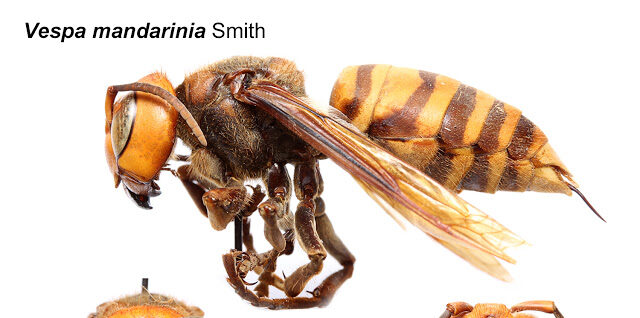| AUBURN UNIVERSITY, Ala. – Neighborhoods and social media are buzzing with hype as citizens are concerned about “murder hornets.” Alabama Cooperative Extension System professionals would like to put this rumor to rest. These stinging insects have not been found in Alabama. However, the detection of Asian giant hornets is unnerving for beekeepers and citizens in the Pacific Northwest.
Asian giant hornets, Vespa mandarinia, are the world’s largest hornet, measuring 1.5 – 2 inches in length.
Alabama Extension entomologist Katelyn Kesheimer said the giant hornets have a very unique coloration that makes them distinguishable from other hornets.
“Their large head is orange or yellow with prominent eyes, and they have a black and yellow-striped abdomen,” she said.
Detection in the U.S.
The pest was first detected in North America in December 2019 when a Washington resident found a large, dead hornet. The hornet was confirmed to be an Asian giant hornet.
Since the positive identification, four more reports have been confirmed in Washington.
Kesheimer said public education and pest eradication plans are already underway.
The United States Department of Agriculture, the Washington State Department of Agriculture and local universities have begun work to educate citizens, conduct surveys, and eradicate the pest.
“Their goal is to eradicate the pest before it becomes established,” Kesheimer said.
Asian giant hornet biology
Asian giant hornets are native to Asia. The hornets are social insects and maintain underground colonies with one queen and multiple workers.
Nests
“These nests are difficult to locate,” Kesheimer said. “Nests are often formed in pre-existing holes in the ground, like a rodent’s nest.”
The hornets will also nest in hollowed tree trunks or in the roots of dead trees.
Colony protection
Much like the fire ant—which Alabamians are very familiar with—the queens are colony leaders. The queens are able to disperse and produce offspring. Therefore, a solitary queen begins a nest and then populates it with workers. Kesheimer said the key to controlling a colony is to kill the queen.
“As social insects, they can carry out coordinated attacks against nests of other bees and wasps,” Kesheimer said. “These group attacks usually occur late in the season as their nests become large and are in need of food. They will ‘slaughter and occupy’ the nests of yellow jackets and paper wasps, as well as honeybees.”
Nourishment
Asian giant hornets are predatory insects. Their diet includes a variety of arthropods. These include: scarab beetles, long-horned beetles, spiders and caterpillars.
European honeybees are the preferred food source for Asian giant hornets because the honeybee hive cannot defend themselves against the hornet. European honeybee hives also offer a bounty of food and are full of protein and fat.
Common look-alikes
While Asian giant hornets have not been identified in Alabama or the southeastern U.S., there are other bees and wasps in Alabama that could be easily mistaken for the Asian giant hornet.
European hornets and Cicada killer wasps resemble Asian giant hornets and could easily cause concern for Alabama homeowners or beekeepers.
Alabama Extension entomologist, Xing Ping Hu, said the Cicada killer and the European hornet are also confused with one another, though the two have different lifestyles.
Cicada killer wasp
“Cicada killer wasps are large solitary wasps that behave differently from social hornets,” Hu said. “The Cicada killer builds nests in the ground by pushing out soil, typically 10-20 inches deep and less than 1 inch wide.”
Hu said Cicada killer wasps can be found small soil mounds in well-drained, sandy soils or loose clay in bare and grass-covered areas. Female wasps hunt for cicadas, sting them to paralyze the prey, then drag the cicada back to the nest to feed the young.
Male cicada wasps are often seen in groups buzzing aggressively above ground. Although the male wasps may look intimidating, they pose no risk to humans. While females can sting, they will not attempt to sting humans unless handled roughly.
European hornet
European hornets are found sporadically throughout the state, as Alabama is likely at the southern edge of their range.
While the European hornet may be mistaken for an Asian giant hornet simply because of their size, hornet behavior may be another reason homeowners could confuse the two.
Similar to Asian giant hornets, European hornets will become aggressive if their nest is threatened. However, the European hornet is not known to be a threat to honeybees.
Threats to honeybees
Kesheimer said Asian giant hornets do post a threat to European honeybees in the U.S.
“While they do prey on other arthropod species, we are most concerned about honeybees because of their value as pollinators and honey-producers,” Kesheimer said. “Beekeepers across all states should be informed about this pest and the progress on eradication efforts.”
Threats to humans
Kesheimer said Asian giant hornets will attack if their colonies or food sources are threatened.
“It is important to remember that these hornets are not typically aggressive toward humans,” Kesheimer said.
Many people have had experience with honeybee stings—the short, barbed stinger becomes lodged in the skin and only allows for one sting. The stinger on V. mandarinia is much larger and contains more venom than bee stingers. The Asian giant hornet stinger has a curved shape with less barbs to allow for easier entry. This means the hornets can sting more than once.
Kesheimer said the average beekeeping suit will not protect keepers from this pest.
“Anyone with an allergy should take extra precautions around any bees or wasps and seek medical attention when and if needed,” she said. “It is important to remain calm when it comes to any types of bees or wasps. Remember, Asian giant hornets only become aggressive when their nest or food source is threatened.”
More information
For more detailed information on identification, biology, and control options, visit United States Department of Agriculture or the Washington State Department of Agriculture.
Read more about Asian giant hornets, also known as murder hornets, in a content piece found on www.aces.edu, titled Asian Giant Hornets Not in Alabama. |



















